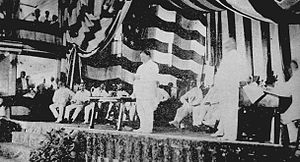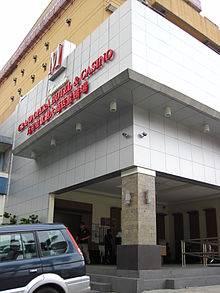- Manila Grand Opera House
-
Manila Grand Opera House Address 925 Rizal Avenue corner Doroteo Jose Street City Manila Country  Philippines
PhilippinesType Opera house Opened Mid-19th century Demolished 1970s Previous names H.T. Hashim’s National Cycle Track (before 1890)
Teatro Nacional (1890-1902)Current use Demolished The Manila Grand Opera House (Filipino: Maringal na Bahay-Opera ng Maynila, abbreviated MGOH) was a theater and opera house located in the Santa Cruz district of Manila on the intersection of Rizal Avenue and Doroteo Jose Street. Built in the mid-19th century as the H.T. Hashim’s National Cycle Track, a circular wooden structure with a nipa roof, the complex served as the center of Philippine culture and the primary theater for the viewing of plays, movies and zarzuelas in Manila prior to the construction of the Cultural Center of the Philippines in the 1960s. The complex had undergone several incarnations and name changes before being demolished. A hotel has since been constructed on the site on where the theater once stood.
Contents
History
 William Howard Taft addressing the audience at the Philippine Assembly in the Manila Grand Opera House.
William Howard Taft addressing the audience at the Philippine Assembly in the Manila Grand Opera House.
The Manila Grand Opera House was built in the mid-19th century as the H.T. Hashim’s National Cycle Track, a circular wooden structure with a nipa roof.[1] In 1890, the name was changed to the Teatro Nacional (National Theater), where the Russian Circus and some American theater companies performed. The name was subsequently changed to the Manila Grand Opera House after an extensive expansion of the original theater and its conversion to an opera house in time for the visit of an Italian opera company in 1902, after the American takeover of the Philippines,[1] and was used as the location of the inauguration of the members of the First Philippine Assembly on October 16, 1907.[2]
The theater served as the home for theater productions, operas and zarzuelas in the Manila area until the onset of World War II. Toribio Teodoro, then referred to as the "shoe king of the Philippines", acquired the property in 1942 and used the MGOH as his residence during the Japanese occupation and the Second Philippine Republic, at which his house and shoe factory were seized by Japanese forces.[1] Floods and a fire damaged the theater in 1943 and 1944, respectively, with reconstruction efforts commencing after the war.
By the 1950s, the theater, equipped with state-of-the-art equipment for both theatrical and cinematic productions, was dubbed its famous title "The Theater with a History".[1] It provided daily entertainment for Manila residents, charging 85 centavos for admission to one theatrical production and one movie. In addition to plays and movie showings, operas, concerts and bodabil (vaudeville) performances were occasionally staged in the complex.[1] Ownership of the complex shifted from the heirs of Teodoro to former Philippine Ambassador to Laos Antonio Cabangon Chua in the 1960s, by which then the MGOH had become a cinema. Part of Cabangon Chua's plan for the complex include the construction of a hotel at the complex.[1]
As economic activity shifted from the Avenida area to Makati City in the 1970s, the MGOH was converted into what was then dubbed the largest nightclub in Manila: Chicks O'Clock, catering to the working class near the Avenida area.[3] The continued slump in Avenida eventually forced the closure of the club and the demolition of the theater.
Manila Grand Opera Hotel
Partially fulfilling Cabangon Chua's vision for the site and as a contribution to the revival of the Avenida area, the Manila Grand Opera Hotel was constructed on the site of the former MGOH. The eight-storey hotel opened in August 2008, with its second building opening sometime in 2009.[1] It will be the only hotel with a direct connection to the Manila Light Rail Transit System, connecting to Doroteo Jose LRT Station, which is also rumored to be constructed on the MGOH grounds.
See also
References
- ^ a b c d e f g Santos, Tina (2008-08-09). "Hint of nostalgia on site of Manila Grand Opera House". Philippine Daily Inquirer (Philippine Daily Inquirer, Inc.). http://newsinfo.inquirer.net/breakingnews/metro/view/20080809-153675/Hint-of-nostalgia-on-site-of-Manila-Grand-Opera-House. Retrieved 2008-08-10.
- ^ Uckung, Peter Jaynul V. (2007-10-16). "Dominador Gomez rattled the first Philippine Assembly". The Manila Times (Manila Times Publishing Corporation). Archived from the original on 2008-01-17. http://web.archive.org/web/20080117064416/http://www.manilatimes.net/national/2007/oct/16/yehey/opinion/20071016opi7.html. Retrieved 2008-01-19.
- ^ Agustin, Victor C. (2008-07-14). "Grand Opera returns as a de-luxe hotel". Cocktales (MediaTrade Exchange, Inc.). http://cocktales.ph/?p=1180. Retrieved 2008-08-10.
External links
Coordinates: 14°36′19.73″N 120°58′53.63″E / 14.6054806°N 120.9815639°E
Categories:- History of the Philippines
- Landmarks in the Philippines
- 19th-century architecture
- Theaters in the Philippines
- Culture of Manila
Wikimedia Foundation. 2010.

